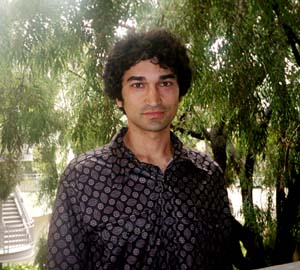Multilevel Genetic Analysis Of the Oncogene TLS/FUS
Ravi Dinakar
Appointment Period: 2004-2008, Grant Years: [20,21,22,23]
 We have been studying the gene TLS/FUS, which upon multiple translocation events leads to both liposarcoma and leukemia. A bioinformatics analysis of the functional domains of TLS reveals that the protein contains a unique combination of motifs: an RNA recognition motif(RRM), 3 RGG motifs, and transcriptional activation domain. The fusion events replace the RMM and RGG motifs with the DNA binding domains of the proteins CHOP, ERG and others.
We have been studying the gene TLS/FUS, which upon multiple translocation events leads to both liposarcoma and leukemia. A bioinformatics analysis of the functional domains of TLS reveals that the protein contains a unique combination of motifs: an RNA recognition motif(RRM), 3 RGG motifs, and transcriptional activation domain. The fusion events replace the RMM and RGG motifs with the DNA binding domains of the proteins CHOP, ERG and others.
By using chip on chip technologies, we discovered that TLS in fact interacts with many promoters, while tiling arrays further determined that TLS can transverse the entire gene. Knockdown experiments showed that loss of TLS reduces expression of these target genes, indicating its importance in producing these transcripts.
To detect whether TLS directly interacts with these transcripts, we performed a CLIP assay, which identifies direct protein-nucleic acid interactions and the sequences of the target nucleic acids. We showed that TLS can interact with both DNA and RNA using this technique, and we identified thousands of RNA sequences with which it interacts. Again, these sequences were located across the transcript, confirming our previous tiling array data. Additionally, previous work using an in vitro technique, designated SELEX, indicated that the consensus sequence that TLS binds is G and U rich; our CLIP data confirmed this (p value 10-27). We also identified an important noncoding RNA as a direct target, which we believe is important in TLS’s transcriptional/splicing functions.
PUBLICATIONS (resulting from this training)
Ravi Dinakar, Gene Yeo, and Xiang-Dong Fu. Oncogenic TLS mediates RNA-dependent activation of gene expression. in preparation).
Other publications (prior to Training Grant appointment):
Grbovic OM, Mathews PM, Jiang Y, Schmidt SD, Dinakar R, Summers-Terio NB, Ceresa BP, Nixon RA, Cataldo AM. Rab5-stimulated up-regulation of the endocytic pathway increases intracellular beta-cleaved amyloid precursor protein carboxyl-terminal fragment levels and Abeta production. J Biol Chem. 2003 Aug 15;278(33):31261-8. Epub 2003 May 20. PubMed PMID: 12761223.
Mathews PM, Guerra CB, Jiang Y, Grbovic OM, Kao BH, Schmidt SD, Dinakar R, Mercken M, Hille-Rehfeld A, Rohrer J, Mehta P, Cataldo AM, Nixon RA. Alzheimer's disease-related overexpression of the cation-dependent mannose 6-phosphate receptor increases Abeta secretion: role for altered lysosomal hydrolase distribution in beta-amyloidogenesis. J Biol Chem. 2002 Feb 15;277(7):5299-307. Epub 2001 Sep 10. PubMed PMID: 11551970.
Multilevel Genetic Analysis Of the Oncogene TLS/FUS
We have been studying the gene TLS/FUS, which upon multiple translocation events leads to both liposarcoma and leukemia. A bioinformatics analysis of the functional domains of TLS reveals that the protein contains a unique combination of motifs: an RNA recognition motif(RRM), 3 RGG motifs, and transcriptional activation domain. The fusion events replace the RMM and RGG motifs with the DNA binding domains of the proteins CHOP, ERG and others.
By using chip on chip technologies, we discovered that TLS in fact interacts with many promoters, while tiling arrays further determined that TLS can transverse the entire gene. Knockdown experiments showed that loss of TLS reduces expression of these target genes, indicating its importance in producing these transcripts.
To detect whether TLS directly interacts with these transcripts, we performed a CLIP assay, which identifies direct protein-nucleic acid interactions and the sequences of the target nucleic acids. We showed that TLS can interact with both DNA and RNA using this technique, and we identified thousands of RNA sequences with which it interacts. Again, these sequences were located across the transcript, confirming our previous tiling array data. Additionally, previous work using an in vitro technique, designated SELEX, indicated that the consensus sequence that TLS binds is G and U rich; our CLIP data confirmed this (p value 10-27). We also identified an important noncoding RNA as a direct target, which we believe is important in TLS’s transcriptional/splicing functions.
Publications: None.
 We have been studying the gene TLS/FUS, which upon multiple translocation events leads to both liposarcoma and leukemia. A bioinformatics analysis of the functional domains of TLS reveals that the protein contains a unique combination of motifs: an RNA recognition motif(RRM), 3 RGG motifs, and transcriptional activation domain. The fusion events replace the RMM and RGG motifs with the DNA binding domains of the proteins CHOP, ERG and others.
We have been studying the gene TLS/FUS, which upon multiple translocation events leads to both liposarcoma and leukemia. A bioinformatics analysis of the functional domains of TLS reveals that the protein contains a unique combination of motifs: an RNA recognition motif(RRM), 3 RGG motifs, and transcriptional activation domain. The fusion events replace the RMM and RGG motifs with the DNA binding domains of the proteins CHOP, ERG and others.